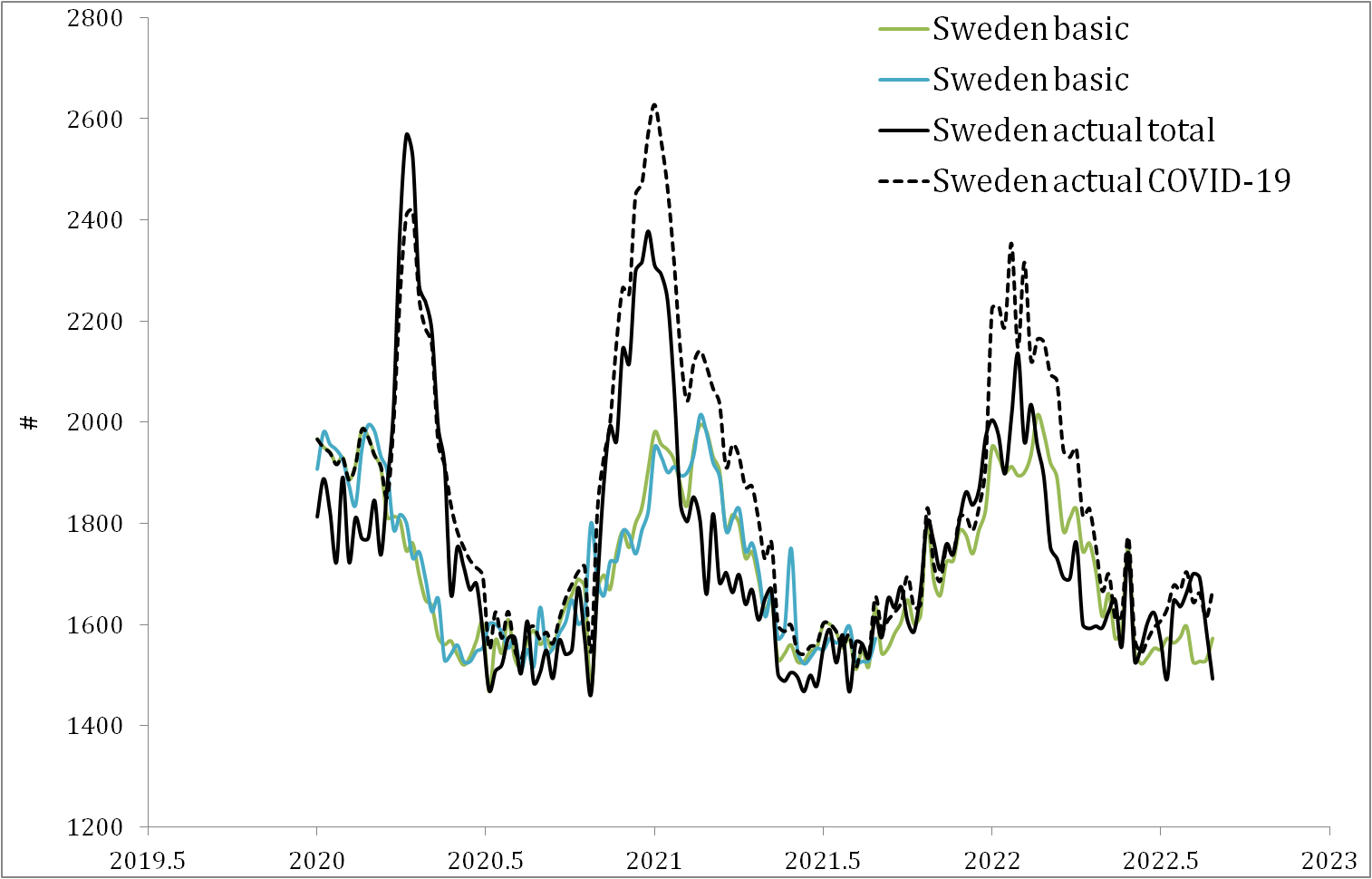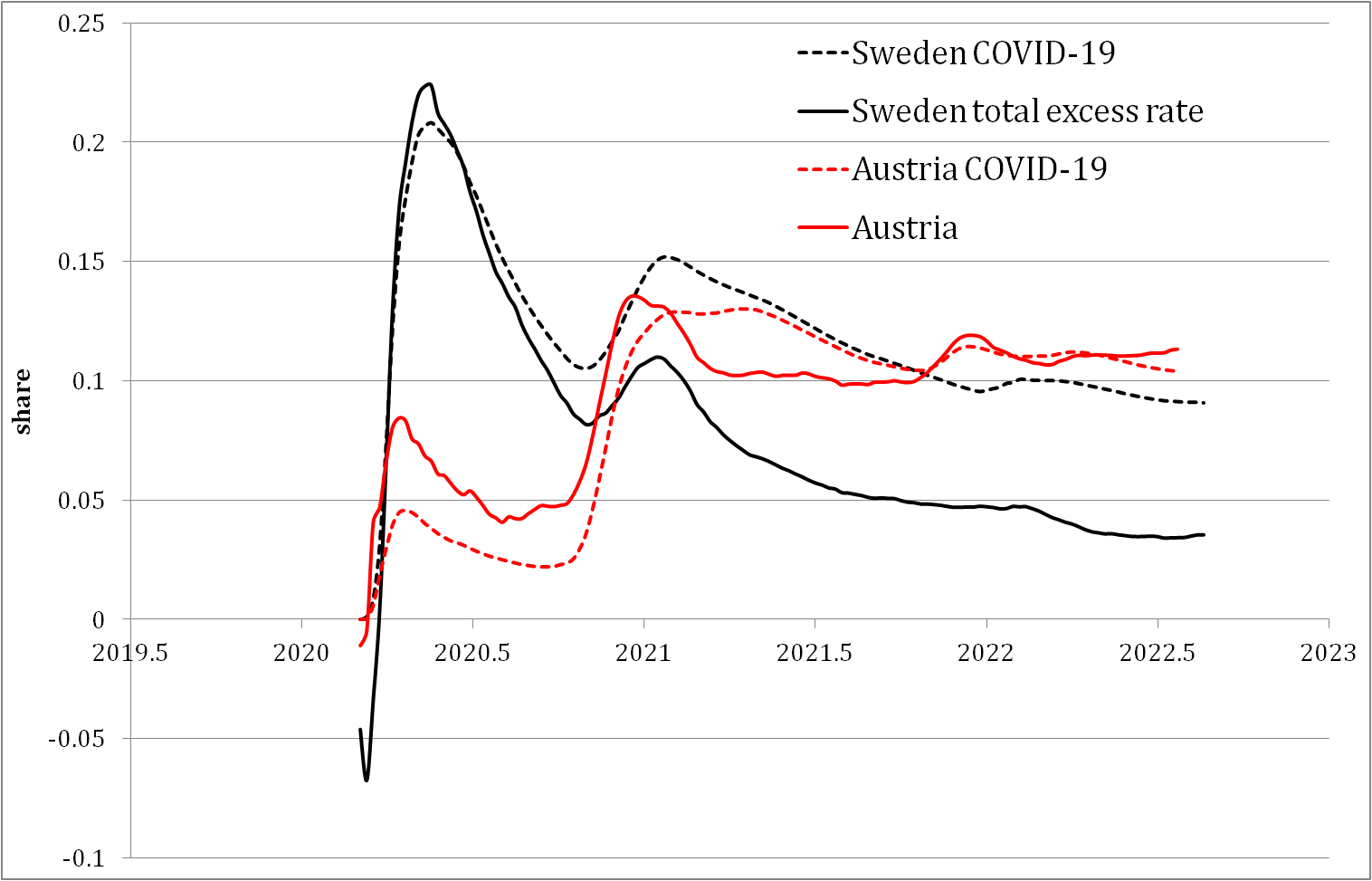We continue comparing the data from OECD.Stat reporting weekly mortality numbers and rates for the pandemic period. The corresponding sets of data for individual countries can be used to compare the outcome of various anti-pandemic strategies. In this post, we compare Austria and Sweden. The COVID-19-related estimates are presented in two different ways: the absolute number of the deviation from the long-term weekly averages and the corresponding rates (% change from average). There are two parameters: total mortality values for all causes and those related to COVID-19 (definitions of COVID-19-related cases are likely to vary between the OECD countries). Figure 1 shows the total and COVID-19-related numbers and rates. One can easily obtain the average numbers from the total rates and deviations from the average values themselves. Figure 2 shows the long-term average weekly numbers, the total weekly numbers, and the COVID-19-related weekly numbers for Sweden. As a check of the basic average (seasonally adjusted) values we have calculated the total weakly death numbers for each week between 2020 and the last estimate in 2022 as shown in Figure 2 by the green curve. Then we shifted this curve 53 months (2020 is the leap year) back (the blue line) and compared the average values for the same week with a one-year shift. One can see that the average values are all pre-pandemic and this makes it possible to get unbiased estimates of the COVID-19 effect on excess mortality.
Figure 1. Total and COVID-19-related numbers
(upper panel) and rates (lower panel). From the total rates and deviations from
the average values,
In Austria, the COVID-19-related curve is almost always below the total curve, but there are some segments where the COVID-19 curve is above the total curve. The highest mortality was observed at the fourth quarter of 2020 and this peak is fully related to COVID-19. At the beginning of 2021 as well as at the beginning of 2022, the COVID-19 curve is above the total curve. In Sweden, the first and almost the highest peak in 2020 was the only one not related to the (fall-winter) seasonal increase but is rather the outcome of the no-lockdown policy.
The relative (% change from average)
values in Figure 1 are can be used for a cross-country comparison. One
can see that only one peak in the second half of 2020 in the lower panel in Figure
1 is synchronized in both countries, with the peak in Austria is the largest
observed during the pandemic. We have calculated the rates in Figure 1 using
the same average estimates for the total and COVID-19 cases as presented in Figure
2. The total deviation from the average values in Sweden was negative
during relatively long periods of time while COVID-19-related deviation numbers
are almost always positive. The average curve and the shifted average curve
almost coincide with the accuracy of calculations using the OECD data with just
one decimal digit. The % change from the average in Sweden draws an interesting
picture: the total mortality rate drops below the average in the pandemic
conditions. The COVID-19-related rate is positive. This rate has to be
non-negative because there can be no negative deviations in the number of
COVID-19-related cases. The total numbers include all causes and thus the
deviation in non-COVID-19 cases can be a large negative number since these
reasons are behind the average curve itself.
Overall, the OECD data for Sweden shows
that the COVID-19 pandemic was severe for the country and the excess death rate
is high mainly because of the virus itself. At the same time, the pandemic
suppressed the severity of all other illnesses (or due to the biased statistics
for the normalized death causes) taken together and the total death rates fell
below the long-term averages despite the pandemic. The driving forces behind
such an outstanding finding are not clear and need deeper investigation of
various death causes and corresponding definitions.
The dynamic parameters in Figure 1 do not present the long-term trends in the efficiency of the specific anti-COVID-19 policies during the pandemic. Figure 3 presents the integral behaviour in the total excess deaths and those related to COVID-19. The total curves are the ratio of the running sum of all excess deaths and the corresponding sum of all average death numbers from week 12 of 2020. The COVID-19 curves are the ratio of the running sum of the COVID-19 numbers and the corresponding sum of all death numbers from week 12 of 2020 (see Figure 4 for corresponding running sums for Austria). Figure 3 shows that Sweden has chosen a better long-term approach that guarantees lower total life losses over the pandemic period. In August 2022, the integral excess death rate during the pandemic was 11% in Austria and less than 4% in Sweden. At the same time, the COVID-19 results are closer for both countries. The advantage of Sweden is not in the treatment of COVID-19 as such but in the reduction of other health risks. (One can also suggest that Austria and Sweden define COVID-19 deaths differently.)
Figure 3. Integral total excess
death rate and COVID-19-related since week 12, 2020.
Figure 4. Austria. The running sums: 1) the average weekly death numbers; 2) the total weekly deviations; 3) the
COVID-19-related weekly deviations.







No comments:
Post a Comment